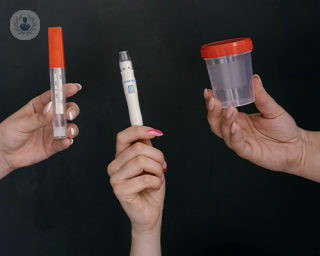Urine test
What is being analysed?
Urine tests, also known as urinalysis, analyse the physical, chemical, and microscopic properties of urine. These tests can detect various substances present in the urine, including proteins, glucose, ketones, blood cells, bacteria, and other waste products.

When is it requested?
Urine tests are commonly requested during routine check-ups, pre-employment screenings, or as part of diagnostic investigations for various medical conditions. They may also be requested if a person experiences symptoms such as frequent urination, pain during urination, or abnormal urine colour.
Why perform the analysis?
Urine analysis helps healthcare providers assess kidney function, screen for urinary tract infections, monitor certain medical conditions such as diabetes and kidney disease, and detect the presence of illicit drugs or medications in the body.
When should the analysis be done?
The timing of urine analysis depends on the specific reason for the test. In some cases, a random urine sample may be sufficient, while in others, a first-morning urine sample (also known as the first void) may be preferred for more accurate results.
What sample is required?
A clean-catch midstream urine sample is typically required for urinalysis. This involves collecting a sample of urine in a sterile container after cleaning the genital area to avoid contamination from bacteria or other substances.
Is any prior preparation necessary?
Prior preparation for urine analysis is usually minimal. However, individuals may be advised to avoid certain foods, drinks, or medications that could affect the test results. It's essential to follow any specific instructions provided by the healthcare provider.
How is it used?
Urinalysis involves a series of tests performed on the urine sample, including visual examination, chemical analysis using test strips, and microscopic examination of sediment. The results help healthcare providers diagnose medical conditions, monitor treatment effectiveness, and guide further diagnostic testing if necessary.
What are the normal values?
|
Parameter |
Normal Range |
|---|---|
|
Color |
Pale yellow to amber |
|
Appearance |
Clear |
|
pH |
4.6 to 8.0 |
|
Specific Gravity |
1.005 to 1.030 |
|
Protein |
< 15 mg/dL |
|
Glucose |
Negative |
|
Ketones |
Negative |
|
Blood |
Negative |
|
Leukocytes |
Negative |
|
Nitrites |
Negative |
|
Bilirubin |
Negative |
|
Urobilinogen |
0.2 to 1.0 mg/dL |
What does having altered values mean?
Altered values in urine analysis may indicate various medical conditions or abnormalities. For example, the presence of protein in the urine could signal kidney disease, while glucose in the urine may indicate diabetes. Abnormalities in urine colour, clarity, pH, or specific gravity may also suggest underlying health issues that require further evaluation and management. It's essential to interpret urine test results in conjunction with other clinical findings and medical history. If any abnormalities are detected, additional testing or consultation with a healthcare provider may be necessary for proper diagnosis and treatment.

